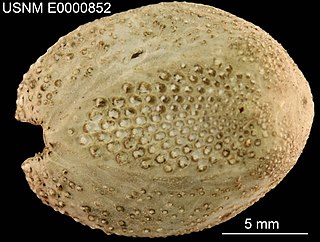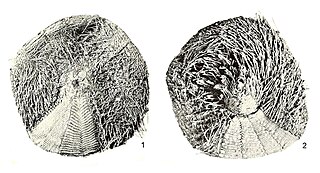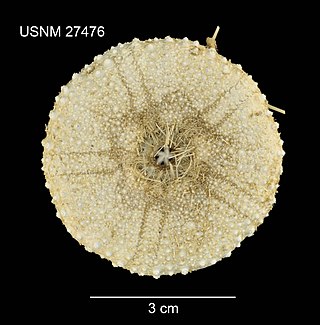
Aceste ovata is a species of sea urchin of the family Schizasteridae. Their armour is covered with spines. It came from the genus Aceste and lives in the sea. Aceste ovata was first scientifically described in 1907 by Alexander Emanuel Agassiz & Hubert Lyman Clark.
Amblypneustes grandis is a species of sea urchin of the family Temnopleuridae. Their armour is covered with spines. It came from the genus Amblypneustes and lives in the sea. Amblypneustes grandis was first scientifically described in 1912 by Hubert Lyman Clark.
Ammotrophus arachnoides is a species of sand dollar of the family Arachnoididea. Their external skeleton, known as a test, is covered with spines. It belongs to the genus Ammotrophus and lives in the sea off southern Australia. Ammotrophus arachnoides was first scientifically described in 1938 by Hubert Clark.
Ammotrophus platyterus is a species of sand dollar of the family Clypeasteridae. Their armour is covered with spines. It came from the genus Ammotrophus and lives in the sea. Ammotrophus platyterus was first scientifically described in 1928 by Hubert Clark.
Anametalia regularis is a species of sea urchin of the family Brissidae. Their armour is covered with spines. It is placed in the genus Anametalia and lives in the sea. Anametalia regularis was first scientifically described in 1925 by Hubert Clark.

Apatopygus occidentalis is a species of sea urchin of the family Apatopygidae. Their armour is covered with spines. It is placed in the genus Apatopygus and lives in the sea. Apatopygus occidentalis was first scientifically described in 1928 by Hubert Lyman Clark, American zoologist.
Aporocidaris fragilis is a species of sea urchin of the family Ctenocidaridae. It is well-armoured with spines. It is placed in the genus Aporocidaris and lives in the sea. Aporocidaris fragilis was first scientifically described in 1907 by Alexander Emanuel Agassiz & Hubert Lyman Clark.

Arachnoides tenuis is a species of sea urchin of the family Clypeasteridae. Their armour is covered with spines. It is placed in the genus Arachnoides and lives in the sea. Arachnoides tenuis was first scientifically described in 1938 by Hubert Lyman Clark.
Araeosoma eurypatum is a species of sea urchin of the family Echinothuriidae. Its armour is covered with spines. It is placed in the genus Araeosoma and lives in the sea. A. eurypatum was first scientifically described in 1909 by Alexander Agassiz and Hubert Clark.

Araeosoma leptaleum is a species of sea urchin of the family Echinothuriidae. Its armour is covered with spines. It is placed in the genus Araeosoma and lives in the sea. A. leptaleum was first scientifically described in 1909 by Alexander Emanuel Agassiz & Hubert Lyman Clark.
Araeosoma paucispinum is a species of sea urchin of the family Echinothuriidae. Its armour is covered with spines. It is placed in the genus Araeosoma and lives in the sea. A. paucispinum was first scientifically described in 1924 by Hubert Lyman Clark, an American zoologist.
Araeosoma tessellatum is a species of sea urchin of the family Echinothuriidae. Its armour is covered with spines. It is placed in the genus Araeosoma and lives in the sea. A. tessellatum was first scientifically described in 1879 by Alexander Emanuel Agassiz.
Araeosoma violaceum is a species of sea urchin of the family Echinothuriidae. Its armour is covered with spines. It is placed in the genus Araeosoma and lives in the sea. A. violaceum was first scientifically described in 1903 by Ole Theodor Jensen Mortensen.

Asthenosoma intermedium is a species of sea urchin of the family Echinothuriidae. Their armour is covered with spines. It is placed in the genus Asthenosoma and lives in the sea. Asthenosoma intermedium was first scientifically described in 1938 by Hubert Lyman Clark.
Brisaster kerguelenensis is a species of sea urchins of the family Schizasteridae. Their armour is covered with spines. Brisaster kerguelenensis was first scientifically described in 1917 by Hubert Lyman Clark.

Chaetodiadema pallidum is a species of sea urchins of the Family Diadematidae. Their armour is covered with spines. Chaetodiadema pallidum was first scientifically described in 1907 by Alexander Emanuel Agassiz and Hubert Lyman Clark.
Chaetodiadema tuberculatum is a species of sea urchins of the Family Diadematidae. Their armour is covered with spines. Chaetodiadema tuberculatum was first scientifically described in 1909 by Hubert Lyman Clark.

Chondrocidaris brevispina, the raspberry sea urchin, is a species of sea urchins of the family Cidaridae. Their armour is covered with short, conical spines.

The Echinothuriidae are a family of sea urchins in the order Echinothurioida. Due to their soft skeletons, most are called "leather urchins", but species in the genus Asthenosoma are also known as "fire urchins" due to their bright colors and painful, venomous sting.

Araeosoma is a genus of deep-sea sea urchins in the family Echinothuriidae.










